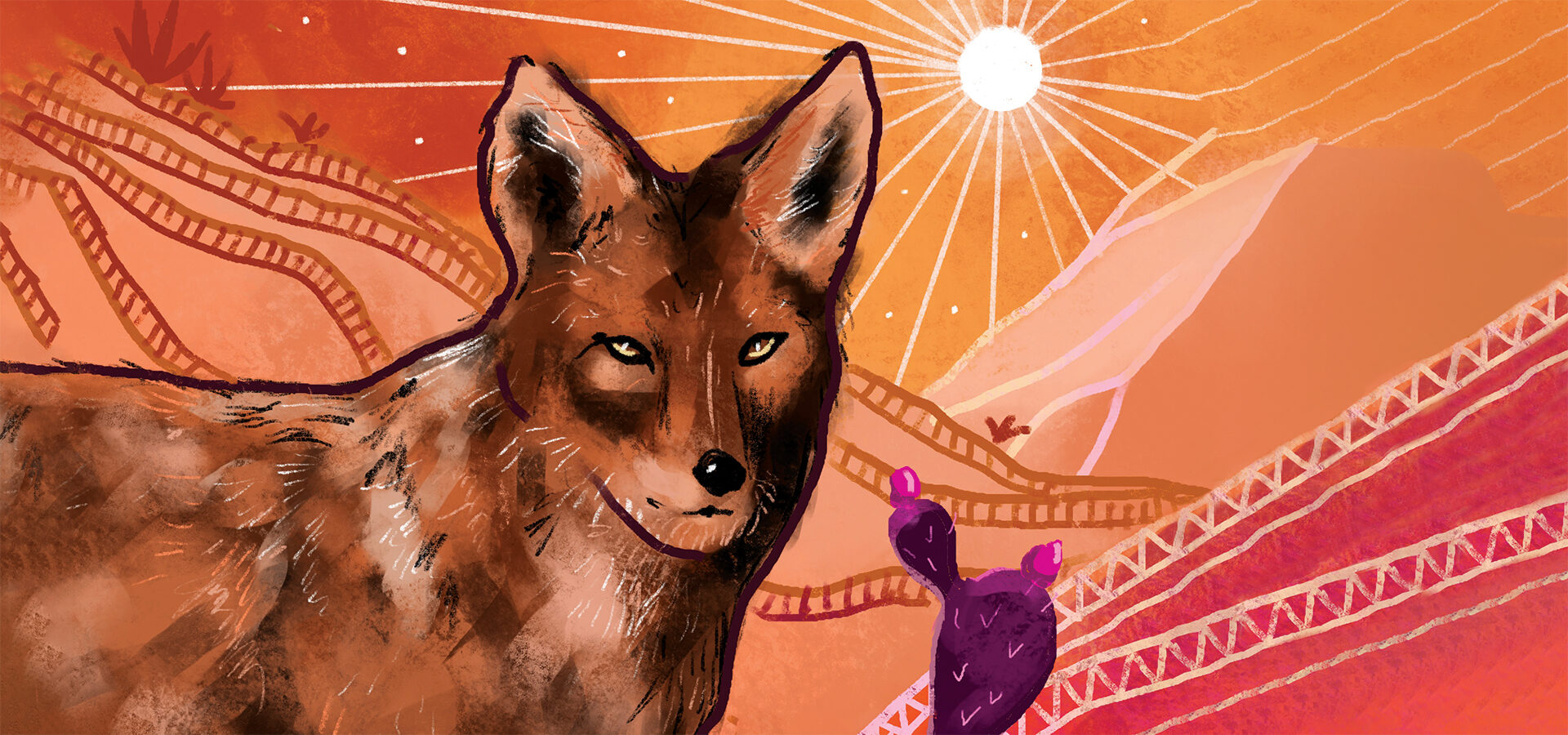
Separating Fact from Fiction When it Comes to Coyotes
So many coyote tales!
-
CategoryHomes
-
Written byAnne M. Russell
-
Illustrations byYuiko Sugino
Almost everyone who lives in the Valley has a coyote story. Like the Native Americans who came before us, we sometimes tell tales that feature a supernatural trickster coyote who is pure evil, and others in which he’s a benevolent friend.
But which are true and which are urban legends? We take a look at the ones we hear most frequently and examine where perception and reality may or may not diverge.
 Perception: “The coyote population is exploding.”
Perception: “The coyote population is exploding.”
Reality: No one knows how many coyotes (aka, Canis latrans, “barking dog”) live in California, nor can anyone say decisively whether or not their numbers are growing. Alexander Heeren, a research scientist with the California Department of Fish and Wildlife who monitors human-wildlife interactions, says, “In the past few years, reports of coyotes have increased, but reporting for all wildlife has increased. That’s probably more a measure of human behavior.”
Heeren theorizes that the combined factors of human expansion into the wildland-urban interface and people being stuck at home during the pandemic led to more observations and encounters. Plus there’s the video doorbell factor, says Seth P.D. Riley, a wildlife ecologist and branch chief for wildlife with the National Park Service in the Santa Monica Mountains National Recreation Area. “Over the last five years people have added Ring cameras, so they’re getting photos of animals in a way they didn’t before,” Riley notes. “I don’t think there’s anything to indicate a big change in the coyote population.”
Perception: “I was stalked by a coyote. It followed me on my walk.”
Reality: “This is not a thing!” exclaims licensed wildlife rehabber and founder/president of the nonprofit Animal Protection Agency, Jami LoVullo. “This ‘stalking’ is a myth that’s perpetuated. It’s a misinterpretation of coyote behavior.”
A coyote’s apparent focus on a human indicates either defense of its den or its naturally curious nature, experts explain. “They want to escort you out of the area near their den. They follow you to make sure you leave,” says LoVullo. Adds Heeren, “We get a lot of reports that coyotes are ‘hunting’ or ‘stalking’ people and often that’s just the coyote watching because they’re curious and inquisitive. They want to see if you’re putting out pet food.”
In fact, LoVullo and Heeren note, one way to discourage coyote visits is to make sure you’re not inadvertently attracting them. Clean up fallen backyard fruit. Don’t feed pets outside. Don’t let birdseed accumulate under feeders. And secure all garbage in closed containers, both to keep coyotes away and also to deter the rodents they prey on.
Perception: “A lone coyote will lure a dog to follow it and once it’s away from the owner, the coyote pack will kill it.”
Reality: Although coyotes will prey on small dogs (as well as chickens and cats), with larger dogs, coyotes are not the aggressors. “Coyotes are extremely smart animals,” LoVullo says. “There’s just no reason they’d risk attacking a German shepherd.” If a dog chases a coyote, however, the coyote may bite in self-defense. But unlike wolves, coyotes don’t hunt in large packs of adults. Coyotes pair up for life and live in nuclear family units with young pups and juveniles, who later disperse to find their own mates.
Perception: “If someone would just trap and relocate the coyotes in my neighborhood, we’d be safer.”
Reality: This notion incorporates a couple fallacies: First, in California it’s illegal to trap and relocate any wild animal. If you catch wildlife, you must then kill it. Second, coyotes don’t recognize concepts like “my neighborhood” or “my backyard.” Heeren explains: “If you remove them, you’ll just get a new pair of coyotes. Most of the state is coyote habitat—there’s no blank space in the map.”
Also, coyotes play an important role in the food chain by controlling gopher, ground squirrel, rat and mice populations. “It’s not a realistic choice to eradicate coyotes,” shares Heeren, “and it’s not ecologically sound.” Installing motion-activated lights will discourage them from prowling your backyard, LoVullo suggests. “You want to reinforce the idea that humans are scary,” Heeren adds.
While many homeowners view coyotes with disdain, wildlife professionals who routinely work with and study the animals speak of them with genuine respect. “Coyotes are super smart,” says Riley. “The vast majority of coyotes are just doing their thing without getting into conflict with humans.”











